Evaluation of Acemannan in Different Commercial Beverages Containing Aloe Vera (Aloe barbadensis Miller) Gel
Abstract
1. Introduction
2. Results and Discussion
2.1. Water Content and Dry Residue of Aloe Vera Gel-Based Beverages
2.2. Alcohol Insoluble Residues (AIRs)
2.3. Carbohydrate Composition
2.4. Acemannan: Amount and Carbohydrate Composition
2.5. Degree of Acetylation (DA) of Acemannan
2.6. Cell Wall Polysaccharides Present in the Aloe Vera Gel-Based Beverages
2.6.1. Cellulose
2.6.2. Hemicelluloses
2.6.3. Pectic Polysaccharides
- Degree of methylesterification (DME)
3. Conclusions
4. Materials and Methods
4.1. Commercial Aloe Vera Gel-Based Beverages
4.2. Lyophilization: Dry Residues
4.3. Alcohol Insoluble Residues (AIRs)
4.4. Isolation of Acemannan Polysaccharide
4.5. Analysis of Carbohydrate Composition
4.6. 1H Nuclear Magnetic Resonance (NMR) Analysis
4.7. Fourier Transformed Infrared (FT-IR) Spectroscopy Analysis
4.8. Statistical Analysis
Author Contributions
Funding
Institutional Review Board Statement
Informed Consent Statement
Data Availability Statement
Acknowledgments
Conflicts of Interest
References
- Paz-Quezada, M.; Salinas, C.; Gotteland, M.; Cardemil, L. Acemannan and Fructans from Aloe vera (Aloe barbadensis Miller) Plants as Novel Prebiotics. J. Agric. Food Chem. 2017, 65, 10029–10039. [Google Scholar] [CrossRef] [PubMed]
- Market Growth Reports. Global Aloe Vera Extract Industry Research Report, Competitive Landscape, Market Size, Regional Status and Prospect. 2022. Available online: https://www.marketgrowthreports.com/global-Aloe-vera-extract-industry-research-report-competitive-landscape-market-21903701 (accessed on 2 May 2023).
- Kima, S.T.; Pressman, P.; Clemens, R.; Moorea, A.; Hamilton, R.; Hayes, W. The absence of genotoxicity of Aloe vera beverages: A review of the literature. Food Chem. Toxicol. 2023, 174, 113628. [Google Scholar] [CrossRef] [PubMed]
- Yadeta, A.T. Food applications of Aloe species: A review. J. Plant Sci. Phytopathol. 2022, 6, 24–32. [Google Scholar]
- Rodríguez-Rodríguez, M.Z.; Meléndez-Pizarro, C.O.; Espinoza-Hicks, J.C.; Quintero-Ramos, A.; Sánchez-Madrigal, M.; Meza-Velázquez, J.A.; Jiménez-Castro, J.A. Effects of UV-C irradiation and traditional thermal processing on acemannan contained in Aloe vera gel blends. Carbohydr. Polym. 2019, 222, 114998. [Google Scholar] [CrossRef]
- Hussain, S.A.; Yadav, V.; Reddi, S.; Patil, G.R.; Singh, R.R.B.; Kapila, S. Thermal processing conditions affect in vitro immunostimulatory activity of Aloe vera juice. J. Appl. Res. Med. Aromat. Plants 2019, 12, 73–77. [Google Scholar] [CrossRef]
- Jettanacheawchankit, S.; Sasithanasate, S.; Sangvanich, P.; Banlunara, W.; Thunyakitpisal, P. Acemannan stimulates gingival fibroblast proliferation; expressions of keratinocyte growth factor-1, vascular endothelial growth factor, and type I collagen; and wound healing. J. Pharmacol. Sci. 2009, 109, 525–531. [Google Scholar] [CrossRef]
- Kumar, S.; Tiku, A.B. Immunomodulatory potential of acemannan (polysaccharide from Aloe vera) against radiation induced mortality in Swiss albino mice. Food Agric. Immunol. 2016, 27, 72–86. [Google Scholar] [CrossRef]
- Rodrigues, L.C.; Fernandes, E.M.; Ribeiro, A.R.; Ribeiro, A.P.; Silva, S.S.; Reis, R.L. Physicochemical features assessment of acemannan-based ternary blended films for biomedical purposes. Carbohydr. Polym. 2021, 257, 117601. [Google Scholar] [CrossRef]
- Lachenmeier, K.; Kuepper, U.; Musshoff, F.; Madea, B.; Reusch, H.; Lachenmeier, D. Quality control of Aloe vera beverages. Electron. J. Environ. Agric. Food Chem. 2005, 4, 1033–1042. [Google Scholar]
- Sehgal, I.; Wallace, D.W.; Scott, M.; Kousoulas, K. An in vitro and in vivo toxicologic evaluation of a stabilized Aloe vera gel supplement drink in mice. Food Chem. Toxicol. 2013, 55, 363–370. [Google Scholar] [CrossRef]
- Miranda, M.; Maureira, H.; Rodríguez, K.; Vega-Gálvez, A. Influence of temperature on the drying kinetics, physicochemical properties, and antioxidant capacity of Aloe Vera (Aloe barbadensis Miller) gel. J. Food Eng. 2009, 91, 297–304. [Google Scholar] [CrossRef]
- Baldi, A.; Sommella, E.; Campiglia, P.; Daglia, M. Aloe gel-base food products: Chemical, toxicological, and regulatory aspects. Regul. Toxicol. Pharmacol. 2021, 119, 104818. [Google Scholar] [CrossRef] [PubMed]
- Nicolau-Lapeña, I.; Colàs-Medà, P.; Alegre, I.; Aguiló-Aguayo, I.; Muranyi, P.; Viñas, I. Aloe vera gel: An update on its use as a functional edible coating to preserve fruits and vegetables. Prog. Org. Coat. 2021, 151, 106007. [Google Scholar] [CrossRef]
- Xie, J.H.; Jin, M.L.; Morris, G.A.; Zha, X.Q.; Chen, H.Q.; Yi, Y.; Li, J.E.; Wang, Z.J.; Gao, J.; Nie, S.P.; et al. Advances on Bioactive Polysaccharides from Medicinal Plants. Crit. Rev. Food Sci. Nutr. 2016, 56, 60–84. [Google Scholar] [CrossRef] [PubMed]
- Liu, C.; Cui, Y.; Pi, F.; Cheng, Y.; Guo, Y.; Qian, H. Extraction, purification, structural characteristics, biological activities and pharmacological applications of acemannan, a polysaccharide from Aloe vera: A review. Molecules 2019, 24, 1554. [Google Scholar] [CrossRef] [PubMed]
- Ramachandra, C.T.; Rao, P.S. Processing of Aloe Vera Leaf Gel: A Review. Am. J. Agric. Biol. Sci. 2008, 3, 502–510. [Google Scholar] [CrossRef]
- Femenia, A.; Sánchez, E.S.; Simal, S.; Rosselló, C. Compositional features of polysaccharides from Aloe vera (Aloe barbadensis Miller) plant tissues. Carbohydr. Polym. 1999, 39, 109–117. [Google Scholar] [CrossRef]
- Maan, A.A.; Reiad-Ahmed, Z.F.; Iqbal-Khan, M.K.; Riaz, A.; Nazir, A. Aloe vera gel, an excellent base material for edible films and coatings. Trends Food Sci. Technol. 2021, 116, 329–341. [Google Scholar] [CrossRef]
- Kim, K.H.; Lee, J.G.; Kim, D.G.; Kim, M.K.; Park, J.H.; Shin, Y.G.; Lee, S.K.; Jo, T.H.; Oh, S.T. The developement of a new method to detect the adulteration of commercial Aloe gel powders. Arch. Pharmacol. Res. 2009, 21, 514–520. [Google Scholar] [CrossRef]
- Manna, S.; McAnalley, B.H. Determination of the position of the O-acetyl group in a β-(1 → 4)-mannan (acemannan) from Aloe barbardensis Miller. Carbohydr. Res. 1993, 241, 317–319. [Google Scholar] [CrossRef]
- Minjares-Fuentes, R.; Femenia, A.; Comas-Serra, F.; Rodríguez-González, V.M. Compositional and structural features of the main bioactive polysaccharides present in the Aloe vera plant. J. AOAC Int. 2018, 101, 1711–1719. [Google Scholar] [CrossRef] [PubMed]
- Shi, X.D.; Yin, J.Y.; Huang, X.J.; Que, Z.Q.; Nie, S.P. Structural and conformational characterization of linear O-acetyl-glucomannan purified from gel of Aloe barbadensis Miller. Int. J. Biol. Macromol. 2018, 120, 2373–2380. [Google Scholar] [CrossRef] [PubMed]
- Sierra-García, G.D.; Castro-Ríos, R.; González-Horta, A.; Lara-Arias, J.; Chávez-Montes, A. Acemannan, an Extracted Polysaccharide from Aloe vera: A Literature Review. Nat. Prod. Commun. 2014, 9, 1217–1221. [Google Scholar] [CrossRef] [PubMed]
- Minjares-Fuentes, R.; Rodríguez-González, V.M.; González-Laredo, R.F.; Eim, V.; González-Centeno, M.R.; Femenia, A. Effect of different drying procedures on the bioactive polysaccharide acemannan from Aloe vera (Aloe barbadensis Miller). Carbohydr. Polym. 2017, 168, 327–336. [Google Scholar] [CrossRef] [PubMed]
- Chokboribal, J.; Tachaboonyakiat, W.; Sangvanich, P.; Ruangpornvisuti, V.; Jettanacheawchankit, S.; Thunyakitpisal, P. Deacetylation affects the physical properties and bioactivity of acemannan, an extracted polysaccharide from Aloe vera. Carbohydr. Polym. 2015, 133, 556–566. [Google Scholar] [CrossRef]
- Campestrini, L.H.; Silveira, J.L.M.; Duarte, M.E.R.; Koop, H.S.; Noseda, M.D. NMR and rheological study of Aloe barbadensis partially acetylated glucomannan. Carbohydr. Polym. 2013, 94, 511–519. [Google Scholar] [CrossRef]
- López, Z.; Salazar-Zúñiga, M.N.; Femenia, A.; Acevedo-Hernández, G.J.; Godínez-Flores, J.A.; Cano, M.E.; Knauth, P. Dry but Not Humid Thermal Processing of Aloe vera Gel Promotes Cytotoxicity on Human Intestinal Cells HT-29. Foods 2022, 11, 745. [Google Scholar] [CrossRef]
- Liu, P.; Chen, D.; Shi, J. Chemical constituents, biological activity and agricultural cultivation of Aloe vera. Asian J. Chem. 2013, 25, 6477–6485. [Google Scholar] [CrossRef]
- Minjares-Fuentes, R.; Medina-Torres, L.; González-Laredo, R.F.; Rodríguez-González, V.M.; Eim, V.; Femenia, A. Influence of water deficit on the main polysaccharides and the rheological properties of Aloe vera (Aloe barbadensis Miller) mucilage. Ind. Crops Prod. 2017, 109, 644–653. [Google Scholar] [CrossRef]
- Femenia, A.; García-Pascual, P.; Simal, S.; Rosselló, C. Effects of heat treatment and dehydration on bioactive polysaccharide acemannan and cell wall polymers from Aloe barbadensis Miller. Carbohydr. Polym. 2003, 51, 397–405. [Google Scholar] [CrossRef]
- Bozzi, A.; Perrin, C.; Austin, S.; Arce Vera, F. Quality and authenticity of commercial Aloe vera gel powders. Food Chem. 2007, 103, 22–30. [Google Scholar] [CrossRef]
- Boudreau, M.D.; Beland, F.A. An Evaluation of the Biological and Toxicological Properties of Aloe barbadensis (Miller), Aloe Vera. J. Environ. Sci. Health 2006, 24, 103–154. [Google Scholar] [CrossRef] [PubMed]
- Simões, J.; Nunes, F.M.; Domingues, P.; Coimbra, M.A.; Domingues, M.R. Mass spectrometry characterization of an Aloe vera mannan presenting immunostimulatory activity. Carbohydr. Polym. 2012, 90, 229–236. [Google Scholar] [CrossRef] [PubMed]
- Talmadge, J.; Chavez, J.; Jacobs, L.; Munger, C.; Chinnah, T.; Chow, J.T.; Williamson, D.; Yates, K. Fractionation of Aloe vera L. inner gel, purification and molecular profiling of activity. Int. Immunopharmacol. 2004, 4, 1757–1773. [Google Scholar] [CrossRef] [PubMed]
- Rodríguez-González, V.M.; Femenia, A.; González-Laredo, R.F.; Rocha-Guzmán, N.E.; Gallegos-Infante, J.A.; Candelas-Cadillo, M.G.; Ramírez-Baca, P.; Simal, S.; Rosselló, C. Effects of pasteurization on bioactive polysaccharide acemannan and cell wall polymers from Aloe barbadensis Miller. Carbohydr. Polym. 2011, 86, 1675–1683. [Google Scholar] [CrossRef]
- Sandhu, A.P.S.; Randhawa, G.S.; Dhugga, K.S. Plant Cell Wall Matrix Polysaccharide Biosynthesis. Mol. Plant 2009, 2, 840–850. [Google Scholar] [CrossRef]
- Scheller, H.V.; Ulvskov, P. Hemicelluloses. Annu. Rev. Plant Biol. 2010, 61, 263–289. [Google Scholar] [CrossRef]
- Cosgrove, D.J. Re-constructing our models of cellulose and primary cell wall assembly. Curr. Opin. Plant Biol. 2014, 22, 122–131. [Google Scholar] [CrossRef]
- Xiang, Z.; Tang, N.; Jin, X.; Gao, W. Fabrications and applications of hemicellulose-based bio-adsorbents. Carbohydr. Polym. 2021, 278, 118945. [Google Scholar] [CrossRef]
- Pauly, M.; Gille, S.; Liu, L.; Mansoori, N.; de Souza, A.; Schultink, A.; Xiong, G. Hemicellulose biosynthesis. Planta 2013, 238, 627–642. [Google Scholar] [CrossRef]
- Gao, Y.; Guo, M.; Wang, D.; Zhao, D.; Wang, M. Advances in extraction, purification, structural characteristics and biological activities of hemicelluloses: A review. Int. J. Biol. Macromol. 2023, 225, 467–483. [Google Scholar] [CrossRef] [PubMed]
- Schmitz, K.; Protzko, R.; Zhang, L.; Benz, J.P. Spotlight on fungal pectin utilization—From phytopathogenicity to molecular recognition and industrial applications. Appl. Microbiol. Biotechnol. 2019, 103, 2507–2524. [Google Scholar] [CrossRef] [PubMed]
- Kyomugasho, C.; Christiaens, S.; Shpigelman, A.; van Loey, A.M.; Hendrickx, M.E. FTIR spectroscopy, a reliable method for routine analysis of the degree of methylesterification of pectin in different fruit- and vegetable-based matrices. Food Chem. 2015, 176, 82–90. [Google Scholar] [CrossRef]
- Umaña, M.M.; Dalmau, M.E.; Eim, V.S.; Femenia, A.; Rosselló, C. Effects of acoustic power and pH on pectin-enriched extracts obtained from citrus by-products. Modelling of the extraction process. J. Sci. Food Agric. 2019, 99, 6893–6902. [Google Scholar] [CrossRef] [PubMed]
- Blumenkrantz, N.; Asboe-Hansen, G. New method for quantitative determination of uronic acids. Anal. Biochem. 1973, 54, 484–489. [Google Scholar] [CrossRef]
- Manrique, G.D.; Lajolo, F.M. FTIR spectroscopy as a tool for measuring degree of methyl esterification in pectins isolated from ripening papaya fruit. Postharvest Biol. Technol. 2002, 25, 99–107. [Google Scholar] [CrossRef]
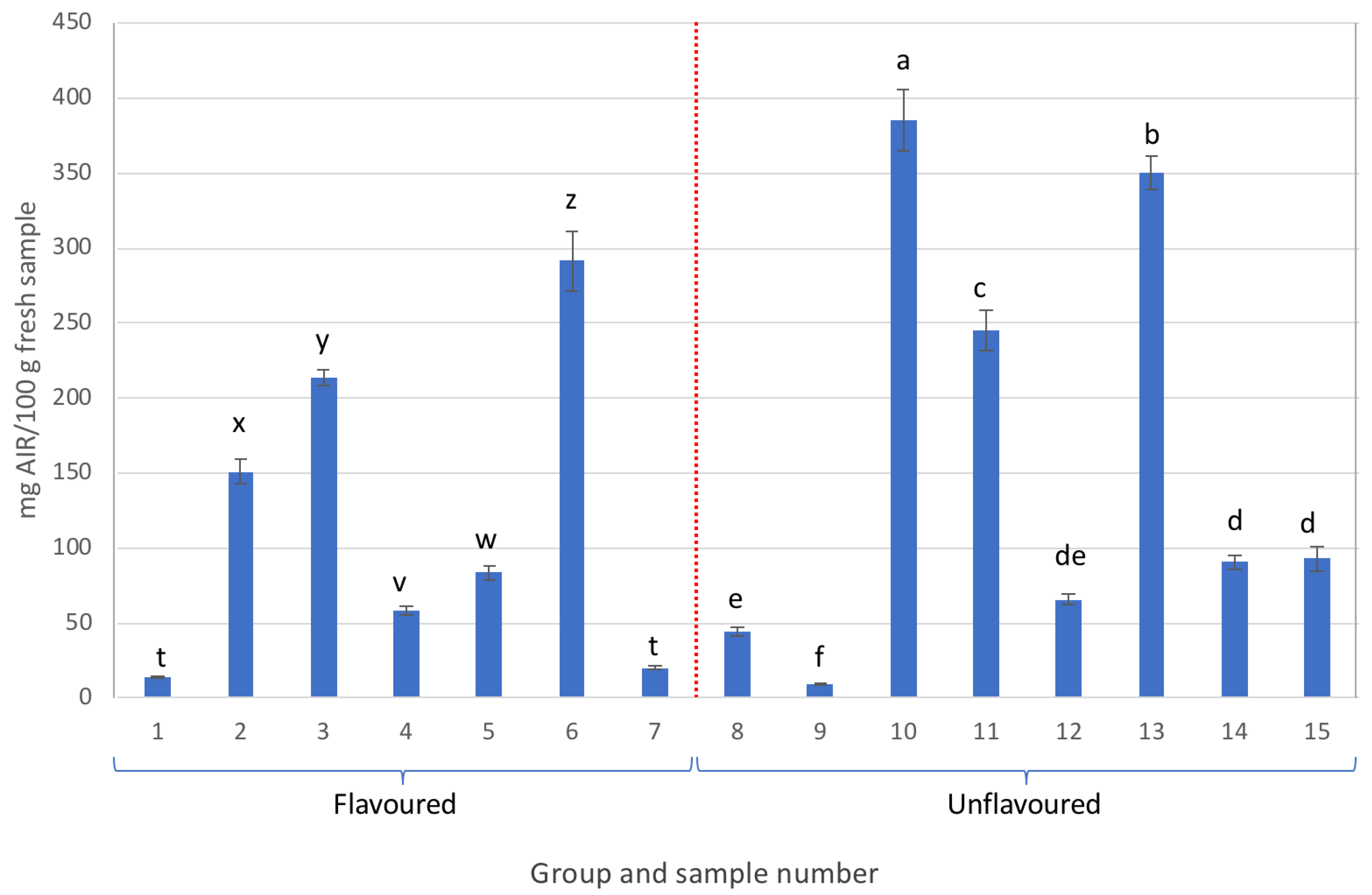
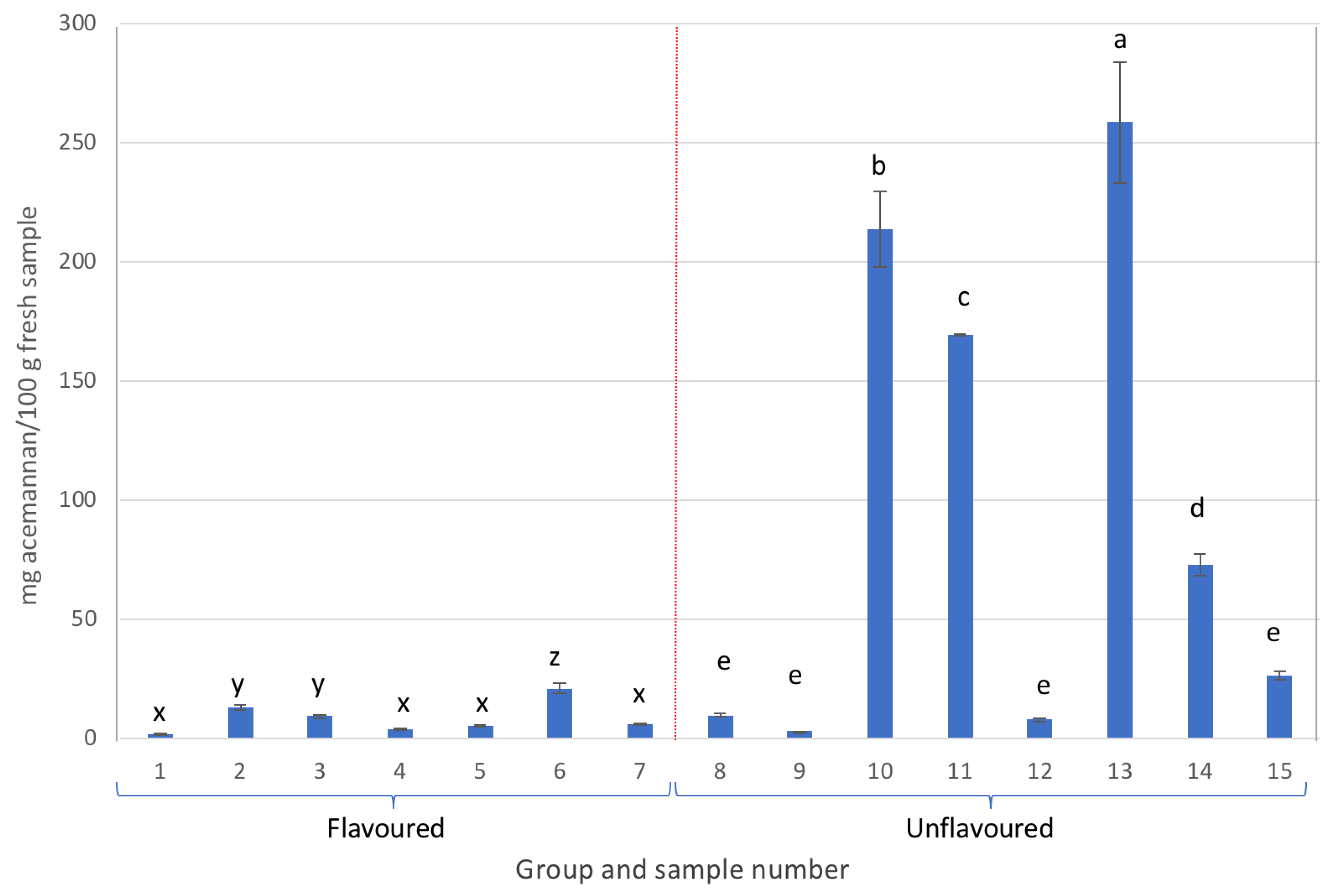
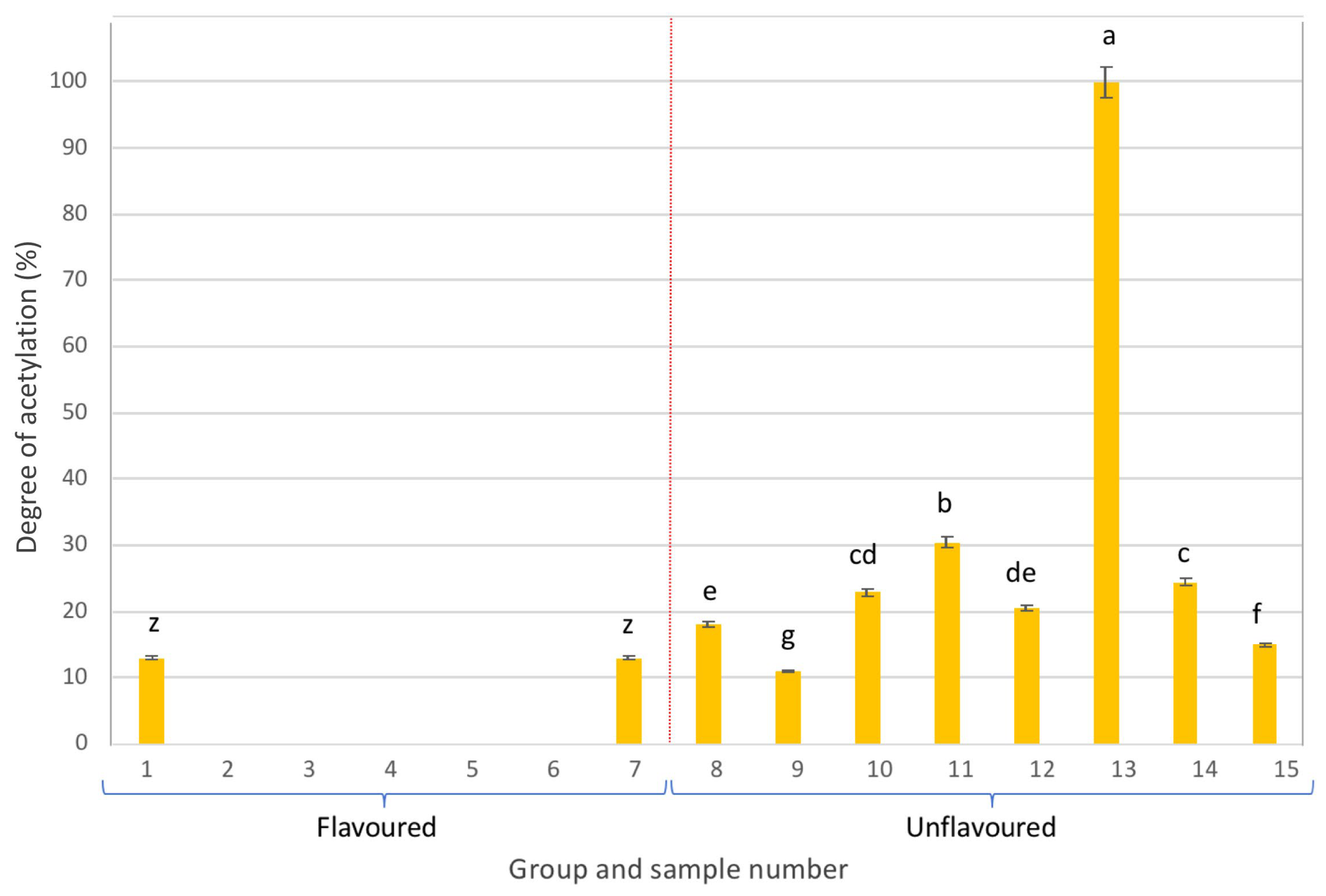
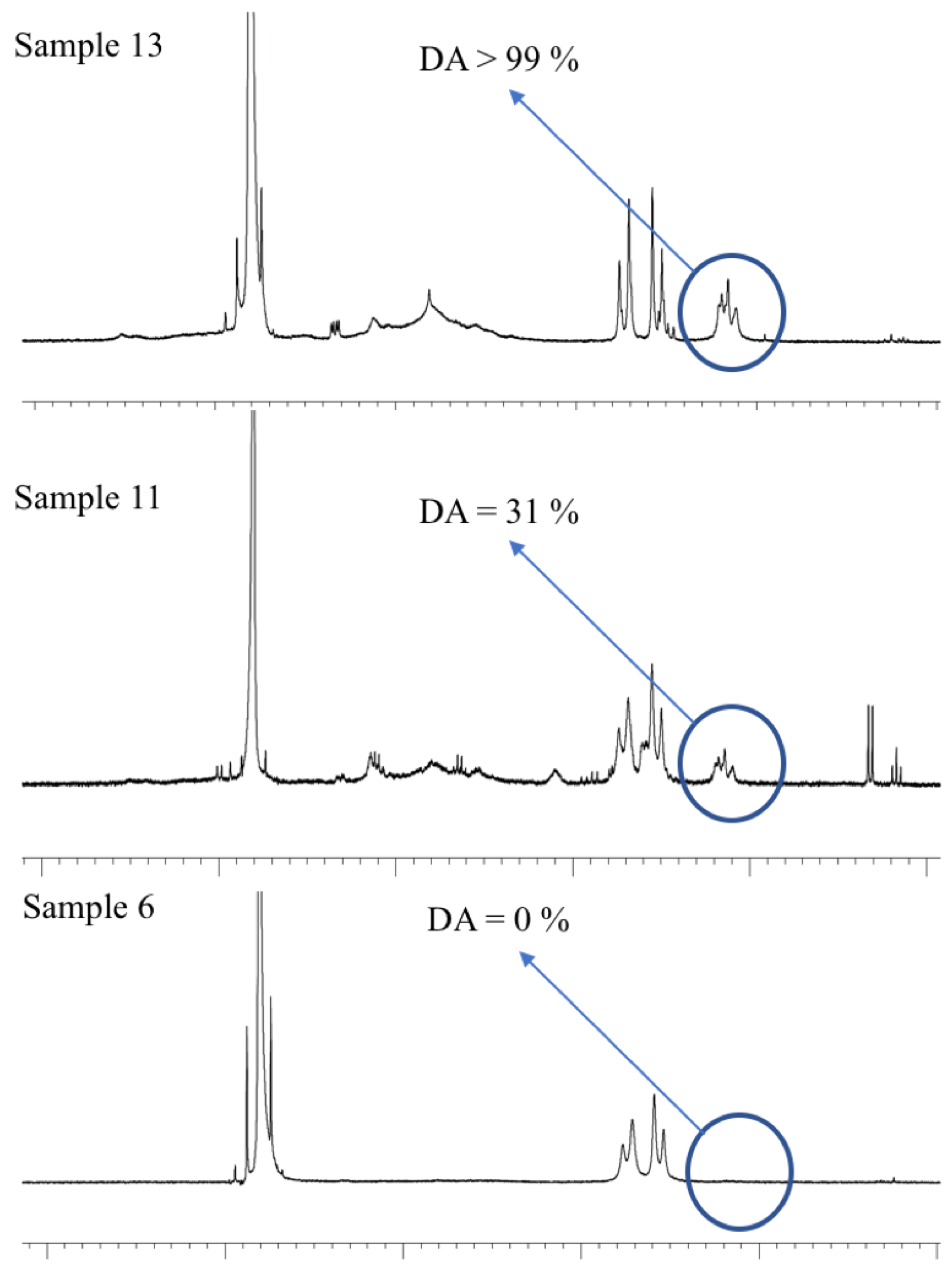
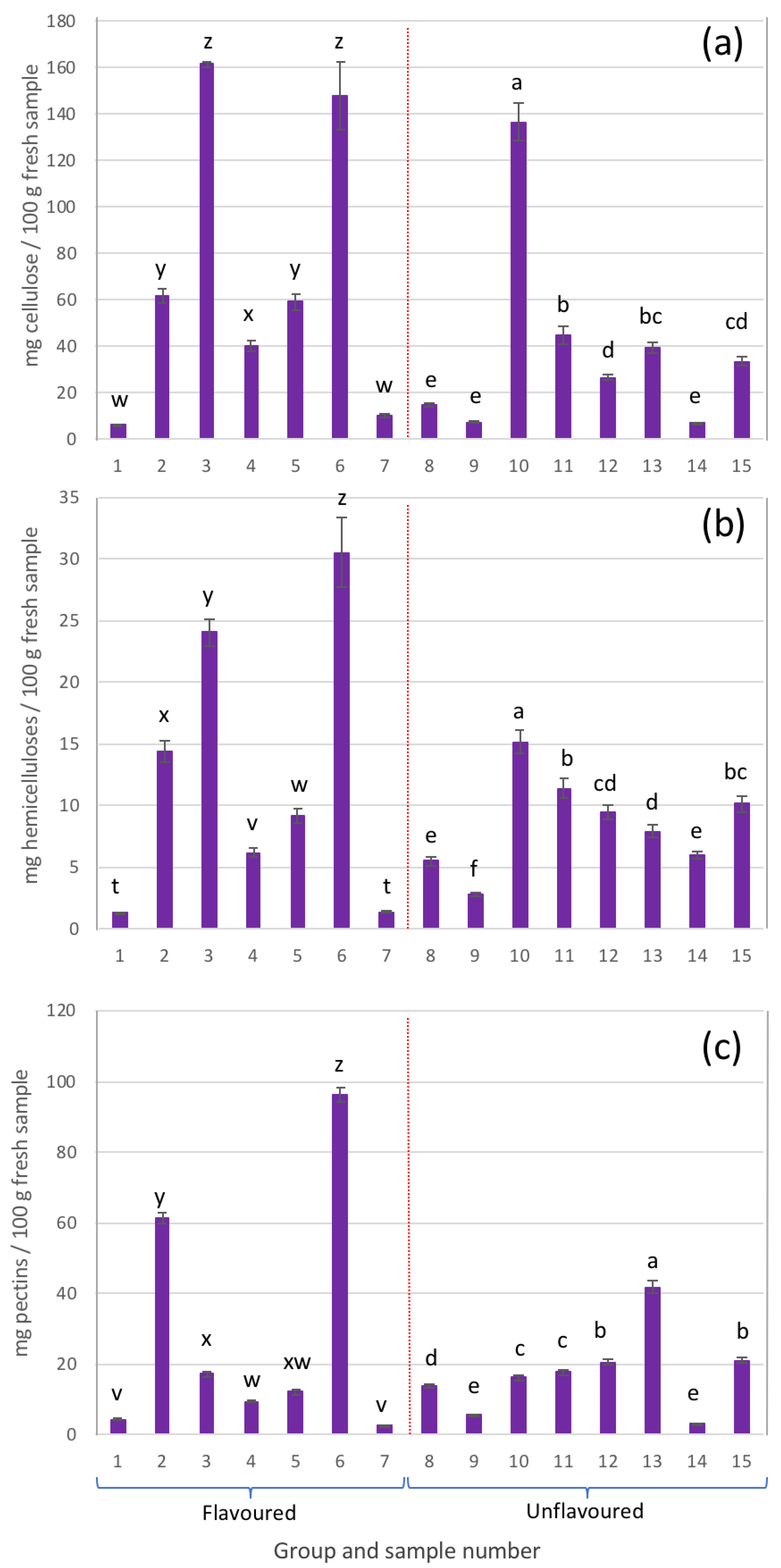
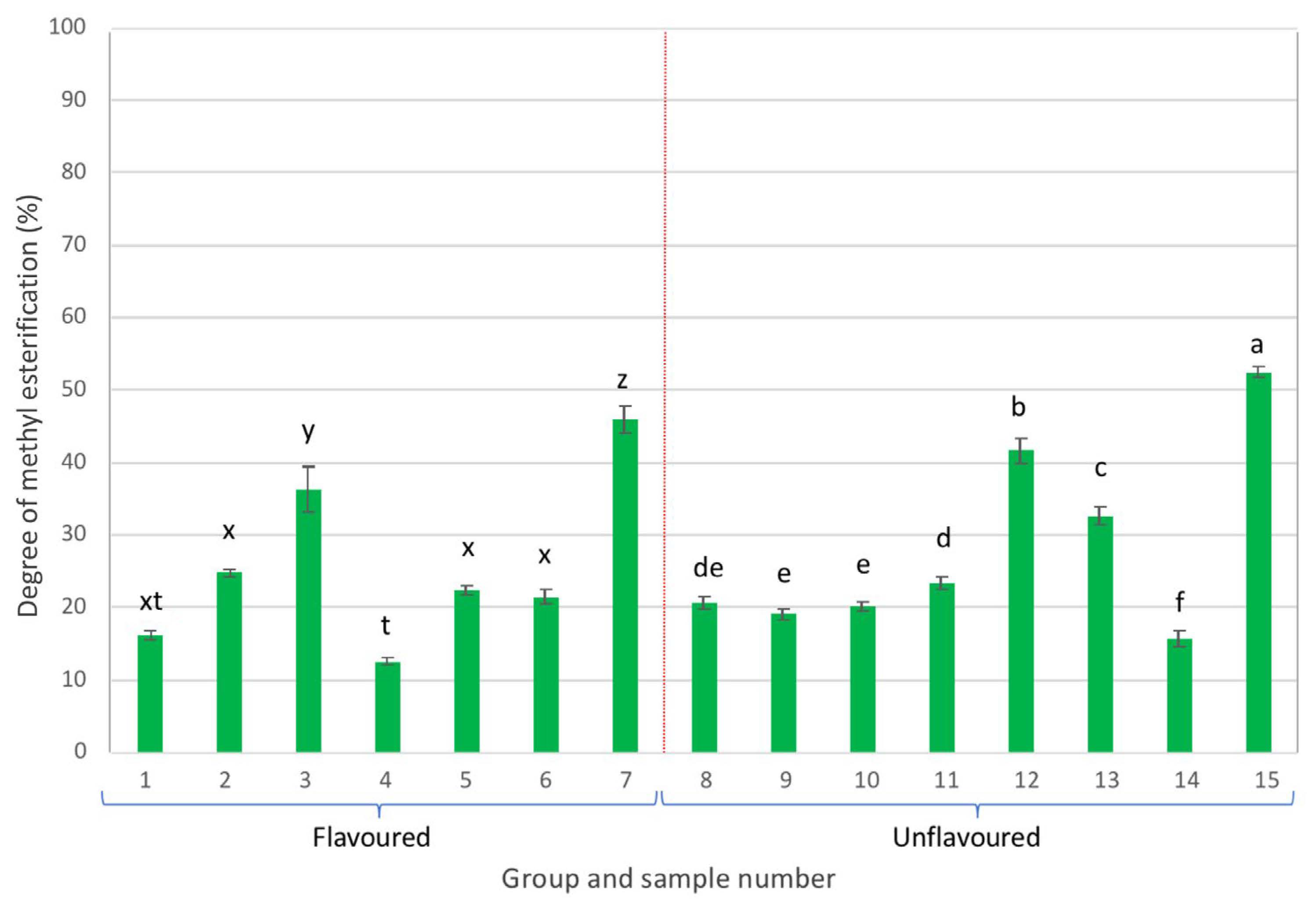
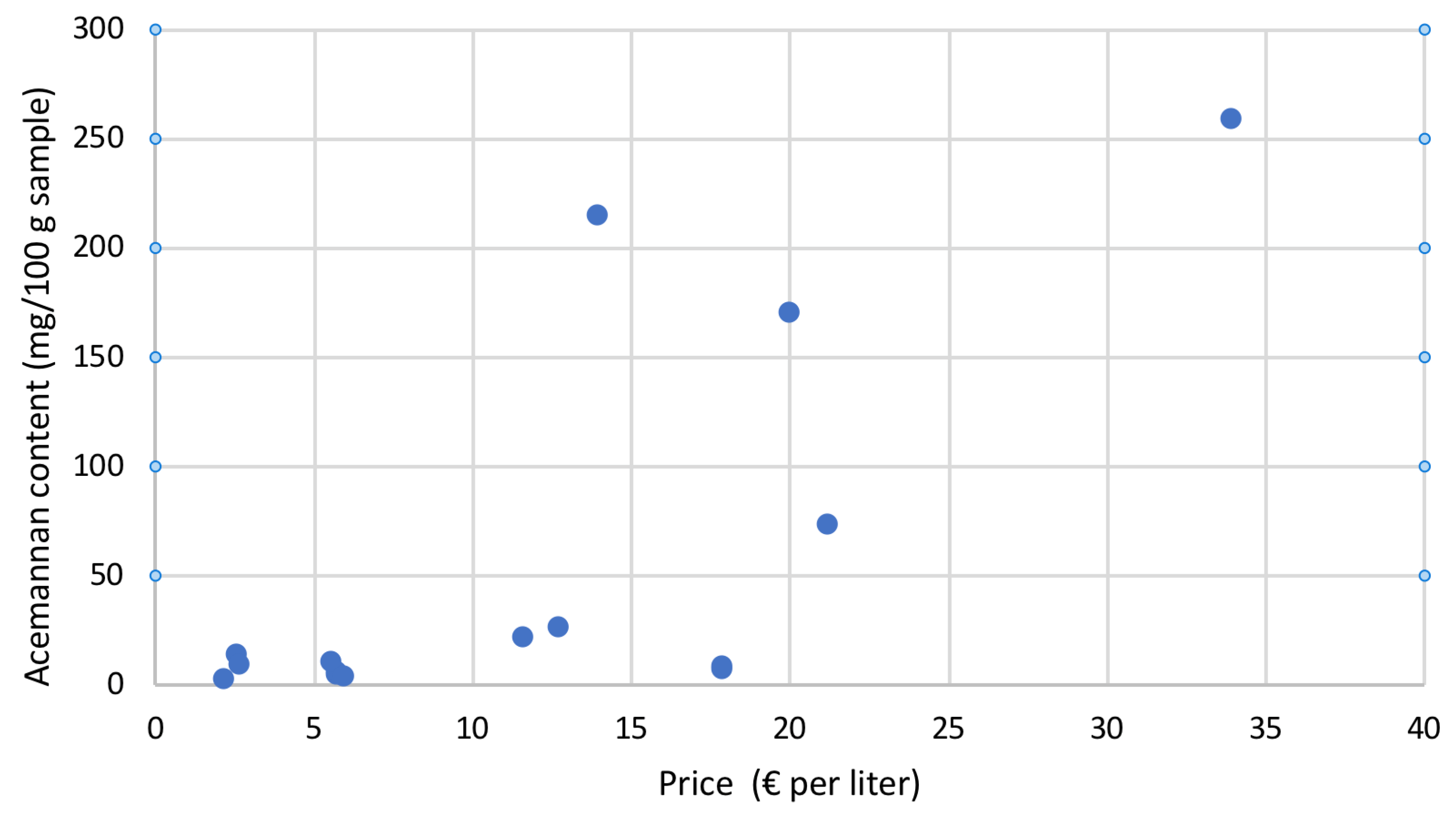
| Group | Sample Number | Water Content (g H2O/100 g Sample) |
|---|---|---|
| Flavoured | 1 | 95.92 ± 0.08 |
| 2 | 99.43 ± 0.05 | |
| 3 | 99.01 ± 0.03 | |
| 4 | 90.34 ± 0.21 | |
| 5 | 89.40 ± 0.14 | |
| 6 | 92.23 ± 0.13 | |
| 7 | 86.21 ± 0.53 | |
| Unflavoured | 8 | 99.53 ± 0.05 |
| 9 | 99.65 ± 0.15 | |
| 10 | 98.64 ± 0.05 | |
| 11 | 99.31 ± 0.07 | |
| 12 | 99.08 ± 0.21 | |
| 13 | 98.92 ± 0.17 | |
| 14 | 99.51 ± 0.04 | |
| 15 | 99.46 ± 0.07 |
| Group | Sample Number | Rha 1 | Fuc | Ara | Xyl | Man | Gal | Glc | UA |
|---|---|---|---|---|---|---|---|---|---|
| Flav. | 1 | 2.3 ± 0.1 | 0.1 ± 0.0 | 0.2 ± 0.0 | 0.5 ± 0.0 | 2.0 ± 0.1 | 0.4 ± 0.0 | 7.0 ± 0.4 | 1.5 ± 0.1 |
| 2 | 4.0 ± 2.7 | 0.5 ± 0.0 | 3.3 ± 0.3 | 7.0 ± 0.6 | 13.3 ± 0.9 | 4.0 ± 0.2 | 68.3 ± 3.3 | 14.0 ± 1.0 | |
| 3 | 5.8 ± 0.1 | 0.4 ± 0.0 | 1.0 ± 0.1 | 5.7 ± 0.4 | 9.5 ± 0.6 | 2.2 ± 0.0 | 179.2 ± 1.4 | 8.2 ± 0.6 | |
| 4 | 4.6 ± 0.2 | 0.3 ± 0.0 | 0.6 ± 0.0 | 1.5 ± 0.1 | 4.0 ± 0.3 | 0.9 ± 0.0 | 44.7 ± 2.5 | 3.4 ± 0.3 | |
| 5 | 4.9 ± 0.2 | 0.3 ± 0.0 | 0.6 ± 0.1 | 2.4 ± 0.1 | 5.6 ± 0.4 | 1.2 ± 0.0 | 65.6 ± 3.7 | 5.4 ± 0.4 | |
| 6 | 8.1 ± 0.5 | 1.6 ± 0.1 | 16.2 ± 1.4 | 12.5 ± 0.8 | 21.4 ± 1.8 | 19.1 ± 0.7 | 164.2 ± 16.2 | 52.9 ± 3.1 | |
| 7 | 0.2 ± 0.0 | 0.0 ± 0.0 | 0.5 ± 0.0 | 0.3 ± 0.0 | 6.5 ± 0.4 | 0.7 ± 0.0 | 11.4 ± 0.7 | 1.4 ± 0.1 | |
| Unflav. | 8 | 0.5 ± 0.0 | 0.4 ± 0.0 | 1.2 ± 0.1 | 3.5 ± 0.2 | 10.1 ± 0.7 | 2.2 ± 0.1 | 16.3 ± 0.9 | 9.8 ± 0.7 |
| 9 | 0.3 ± 0.0 | 0.2 ± 0.0 | 0.4 ± 0.0 | 1.8 ± 0.1 | 3.2 ± 0.2 | 0.8 ± 0.0 | 8.2 ± 0.5 | 4.2 ± 0.3 | |
| 10 | 0.0 ± 0.0 | 0.0 ± 0.0 | 6.7 ± 0.6 | 0.0 ± 0.0 | 214.1 ± 16.0 | 9.0 ± 0.7 | 151.8 ± 8.7 | 0.4 ± 0.0 | |
| 11 | 0.0 ± 0.0 | 0.0 ± 0.0 | 5.2 ± 0.4 | 6.4 ± 0.3 | 169.7 ± 0.3 | 6.0 ± 0.2 | 50.1 ± 4.3 | 6.6 ± 0.5 | |
| 12 | 0.8 ± 0.0 | 0.7 ± 0.1 | 1.1 ± 0.1 | 5.8 ± 0.4 | 8.2 ± 0.5 | 2.2 ± 0.1 | 29.7 ± 1.7 | 16.6 ± 1.2 | |
| 13 | 1.5 ± 0.1 | 0.1 ± 0.0 | 3.4 ± 0.3 | 3.5 ± 0.2 | 258.7 ± 25.6 | 5.7 ± 0.2 | 43.9 ± 2.5 | 31.3 ± 2.9 | |
| 14 | 0.0 ± 0.0 | 0.0 ± 0.0 | 0.4 ± 0.0 | 5.2 ± 0.3 | 73.1 ± 4.8 | 1.3 ± 0.1 | 7.8 ± 0.4 | 1.6 ± 0.1 | |
| 15 | 1.1 ± 0.0 | 0.6 ± 0.1 | 1.9 ± 0.2 | 5.8 ± 0.4 | 26.7 ± 1.7 | 4.6 ± 0.2 | 37.2 ± 2.1 | 13.5 ± 1.0 |
| Group | Sample Number | Man 1 | Gal | Glc |
|---|---|---|---|---|
| Flavoured | 1 | 77.4 ± 1.0 | 1.1 ± 0.1 | 21.5 ± 0.5 |
| 2 | 78.2 ± 0.9 | 1.0 ± 0.1 | 20.8 ± 0.8 | |
| 3 | 75.6 ± 1.7 | 0.7 ± 0.0 | 23.7 ± 0.6 | |
| 4 | 77.4 ± 0.8 | 0.6 ± 0.1 | 22.0± 0.5 | |
| 5 | 78.3 ± 1.0 | 0.4 ± 0.1 | 21.3 ± 0.7 | |
| 6 | 77.8 ± 0.9 | 1.2 ± 0.2 | 21.0 ± 0.3 | |
| 7 | 77.3 ± 1.8 | 0.5 ± 0.1 | 22.2 ± 0.5 | |
| Unflavoured | 8 | 79.3 ± 1.7 | 1.3 ± 0.4 | 19.4 ± 0.7 |
| 9 | 79.9 ± 1.2 | 1.2 ± 0.5 | 18.9 ± 0.3 | |
| 10 | 77.0 ± 0.9 | 1.8 ± 0.2 | 21.2 ± 0.8 | |
| 11 | 78.5 ± 1.3 | 1.4 ± 0.1 | 20.1 ± 0.5 | |
| 12 | 76.1 ± 0.9 | 2.2 ± 0.2 | 21.7 ± 0.9 | |
| 13 | 82.5 ± 0.7 | 1.1 ± 0.1 | 16.4 ± 1.1 | |
| 14 | 79.1 ± 0.9 | 0.8 ± 0.2 | 20.1 ± 0.9 | |
| 15 | 78.0 ± 0.7 | 1.5 ± 0.2 | 20.5 ± 0.7 |
| Group | Sample Number | % Aloe Vera Gel (as Labelled) | Price per Litre (€) | Other Ingredients (as Labelled) |
|---|---|---|---|---|
| Flavoured | 1 | 30.0 | 2.18 | Fructose, citric acid, sodium citrate, grape aroma, vitamin C, gelan gum, calcium lactate |
| 2 | 30.0 | 2.60 | Fructose, citric acid, sodium citrate, grape aroma, vitamin C, gelan gum, calcium lactate | |
| 3 | 30.0 | 2.70 | Fructose, citric acid, grape juice, ascorbic acid, carboxymethyl cellulose, steviol | |
| 4 | 30.0 | 5.70 | Fructose, calcium lactate, citric acid, sodium citrate, grape flavour, sucrose, gelan gum | |
| 5 | 30.0 | 5.70 | Fructose, calcium lactate, citric acid, sodium citrate, pomegranate flavour | |
| 6 | 60.0 | 11.63 | Apple juice, sucralose, citric acid, potassium sorbate, sodium benzoate | |
| 7 | 76.8 | 17.90 | Pomegranate juice, citric acid, ascorbic acid | |
| Unflavoured | 8 | 99.5 | 5.55 | Citric acid, ascorbic acid |
| 9 | 99.5 | 5.99 | Citric acid, ascorbic acid | |
| 10 | 99.7 | 13.99 | Citric acid, potassium sorbate, ascorbic acid | |
| 11 | 99.7 | 19.99 | Citric acid | |
| 12 | 99.8 | 17.90 | Citric acid, ascorbic acid | |
| 13 | 99.8 | 33.90 | Citric acid | |
| 14 | 99.8 | 21.20 | Citric acid | |
| 15 | 99.8 | 12.75 | Citric acid, green tea, stevia |
Disclaimer/Publisher’s Note: The statements, opinions and data contained in all publications are solely those of the individual author(s) and contributor(s) and not of MDPI and/or the editor(s). MDPI and/or the editor(s) disclaim responsibility for any injury to people or property resulting from any ideas, methods, instructions or products referred to in the content. |
© 2023 by the authors. Licensee MDPI, Basel, Switzerland. This article is an open access article distributed under the terms and conditions of the Creative Commons Attribution (CC BY) license (https://creativecommons.org/licenses/by/4.0/).
Share and Cite
Comas-Serra, F.; Estrada, P.; Minjares-Fuentes, R.; Femenia, A. Evaluation of Acemannan in Different Commercial Beverages Containing Aloe Vera (Aloe barbadensis Miller) Gel. Gels 2023, 9, 552. https://doi.org/10.3390/gels9070552
Comas-Serra F, Estrada P, Minjares-Fuentes R, Femenia A. Evaluation of Acemannan in Different Commercial Beverages Containing Aloe Vera (Aloe barbadensis Miller) Gel. Gels. 2023; 9(7):552. https://doi.org/10.3390/gels9070552
Chicago/Turabian StyleComas-Serra, Francesca, Paula Estrada, Rafael Minjares-Fuentes, and Antoni Femenia. 2023. "Evaluation of Acemannan in Different Commercial Beverages Containing Aloe Vera (Aloe barbadensis Miller) Gel" Gels 9, no. 7: 552. https://doi.org/10.3390/gels9070552
APA StyleComas-Serra, F., Estrada, P., Minjares-Fuentes, R., & Femenia, A. (2023). Evaluation of Acemannan in Different Commercial Beverages Containing Aloe Vera (Aloe barbadensis Miller) Gel. Gels, 9(7), 552. https://doi.org/10.3390/gels9070552







